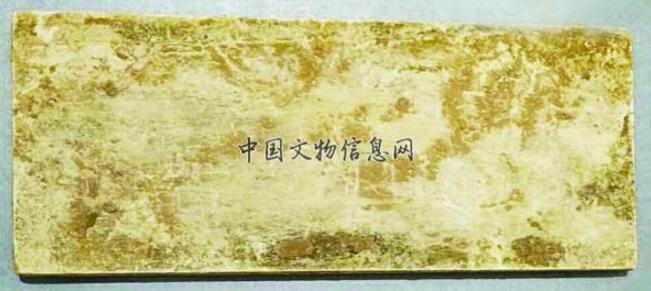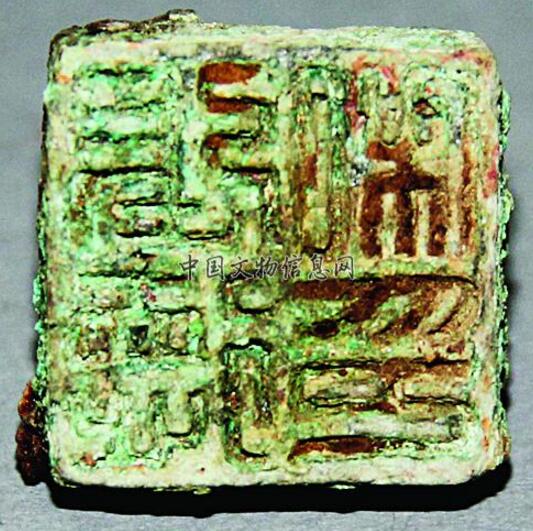Information
Tombs of later Warring States to Early Eastern Han Dynasty found in Anhui Province
From August to September 2016, Anhui Provincial Institute of cultural relics and Archaeology and Huaibei Municipal Museum carried out joint salvage excavation to the newly found cemetery of Han dynasty. Altogether 27 ancient tombs were excavated, numbered as M1 to M27. Six tombs of them were damaged seriously by construction digging and other tombs were actually cleared, among which sixteen were earthen pit tombs, three were brick chamber tombs and 2 were brick-stone tombs.
Bronze belt found in Tomb M20
Excavation achievements
Sixteen earthen pit tombs consisted of joint-burial earthen shaft tomb and single-burial earthen shaft tomb.
M14 was the only joint-burial earthen shaft tomb. The tomb was rectangular in plane. The bottom was 2.8 meters in length and 1.5 meters in width. Obvious wooden coffin trace was found at the bottom. The human skeleton on the west was well preserved. The parts beneath the knees of the skeleton on the east were decayed and missing. The burial objects were found all in the coffin. There were two pieces of silver wares, one bronze buckle, one iron sword, some copper coins, two funeral object used for burial purposes (meant to be placed on the tongue), one iron blade and one bronze seal.
Fifteen single burial earthen pit tombs were found. Taking M13 as an example, it was an earthen shaft pit tomb in the shape of rectangle and the burial objects were found at the east end of the bottom, to the east of the feet of the tomb owner. There was a mellow earth second-tiered platform, 2.70 meters in length, 0.15 meter in width and 0.50 meters in height. The burial utensil was decayed, so it was impossible to tell its structure. The human skeleton was preserved relatively well with the head heading west. The burial objects were found in the head niche in the east end of the bottom. There were two pottery jars, two pottery cases, two pottery tripods-ding, two pottery bottles and two copper coins.
Tablet found in Tomb M7
Three brick chamber tombs were found. Taking M27 as an example, it’s in the shape of rectangle, 1.96 meters from bottom to the surface, 2.48 meters in length and 0.86 meters in width. The chamber walls were piled of bricks with staggered joints. The burial utensil was decayed and missing, making it impossible to tell its structure. The human skeleton was preserved in general condition with the body lying with face facing upward, limbs bent and heading west. There were few burial objects placed to the east of the chamber, including one pottery jar and two copper coins.
Two brick-stone tombs were found. Taking M7 as an example, it surface was in the shape of rectangle, with the remaining part 6.96 meters in length, 3.62 meters in width and 0.81 meter bottom to top. The chamber walls were made of strip shape stone piled with staggered joints. M7 was made up of front chamber, back chamber and side chamber. The tomb ground was paved with a single layer of bricks in the style of flemish garden wall bond (sanshunyiding in Chinese). The burial utensil was decayed, making it impossible to tell its structure. The burial objects were found in the front chamber. They were 1 pottery amphora, 1 grinding plate, 1 pottery ware, 1 iron mirror, 1 parasol top (kind of chariot components), 1 lead ware, 1 copper coin, 1 copper ring, 1 pottery plate, 1 iron sharpener, 1 pottery vessel-dou and some pottery fragments.
Bronze seal found in Tomb M14
Excavation significance
Through tomb structure and assemblages analysis, we speculated these ancient tombs were in the later Warring States period to the early Eastern Han Dynasty. The earthen pit tomb M20 was speculated to be in the late Warring States period for the bronze buckle inlaid with gold and jade showed strong feature of that time, providing essential material for the study of accessory of Chu State people. 4 tripods-ding, 6 bottles, 7 vessels-dou and jade disk with grain patterns were found in M12. Judging from the ware collection as well as their features, M12 was similar to the small and medium tombs of late Warring States period in the Central Plain. But the tripods appeared in even number and the jars appeared in odd number, which went against the common rule in Ji lineage of the Zhou Dynasty in the central plain. Obviously, it reflected influence of Chu culture because here was in the boundary of central culture and Chu culture as well as the occupation by Chu State people in the later Warring States period. M13 and other earthen pit tombs belonged to the Western Han Dynasty, mostly with pottery tripods, cases and bottles as burial objects. Most of the brick chamber tombs and brick-stone tombs were in the later Western Han Dynasty to the early Eastern Han Dynasty.
Through the excavation, we have reason to believe that this area was the cemetery of Xiangcheng residence from Eastern Zhou to Han Dynasty. The cemetery was in large scale and the dates of the tombs were in sequence throughout the Eastern Zhou Dynasty to the Han Dynasty. The excavation offered valuable material for the study of the tombs surrounding Xiangcheng ancient city and their burial customs as well as burial features. (Translator: Yuan Yuan)
Category: English
News
Information
Key words:



